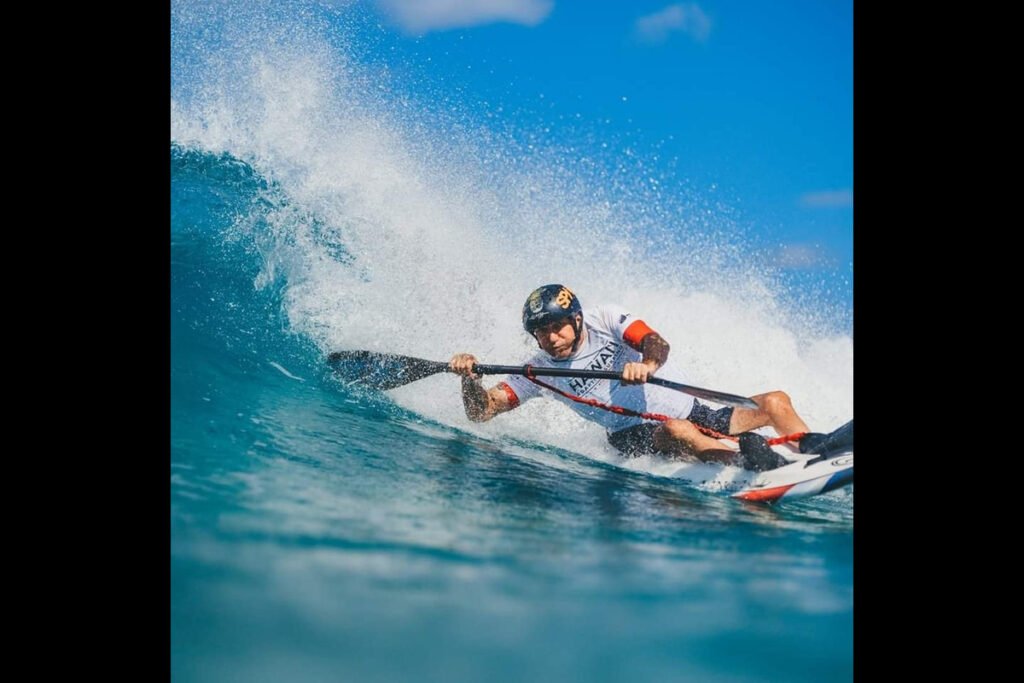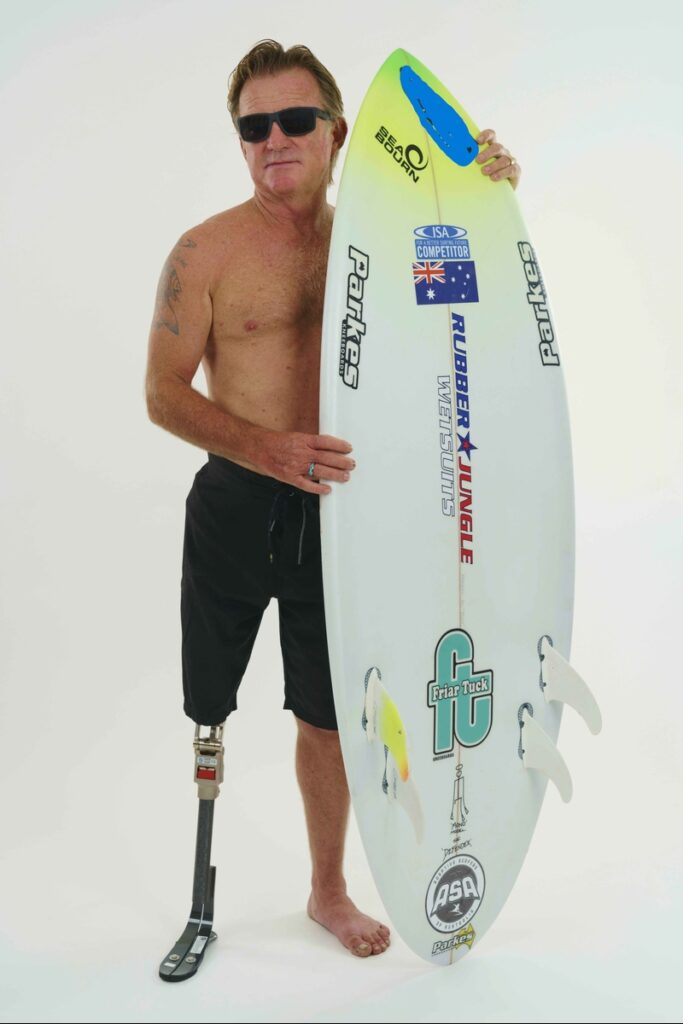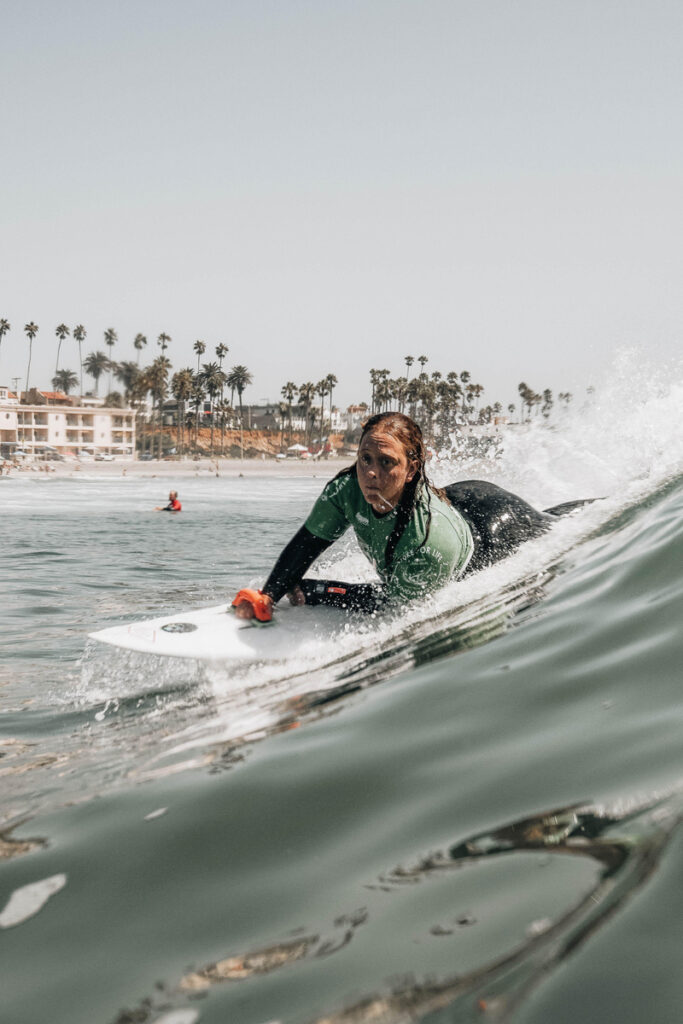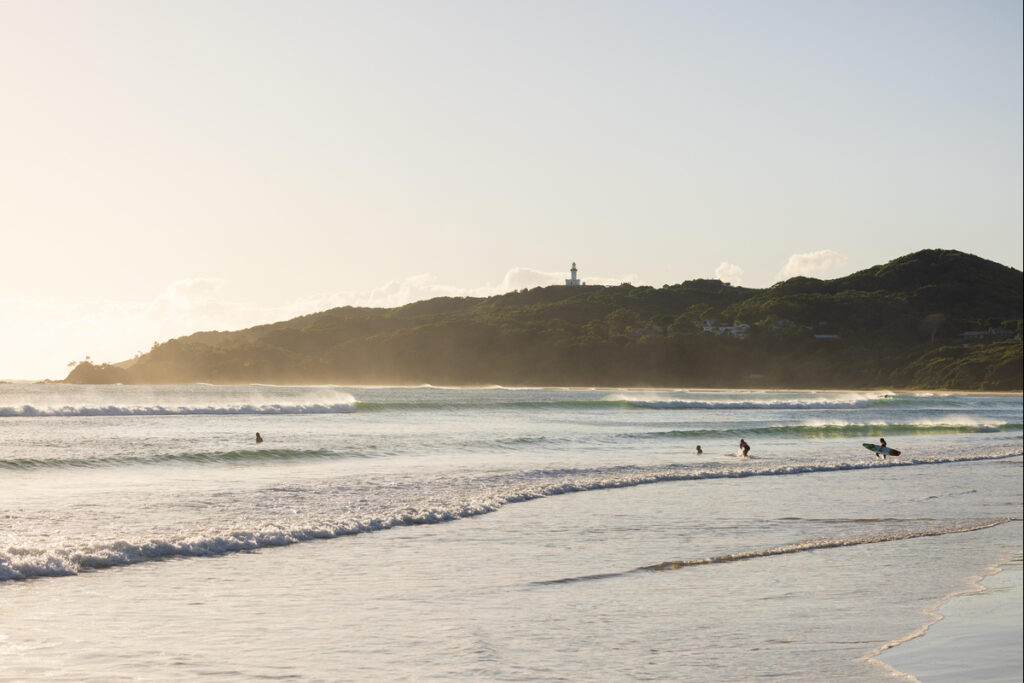At the Byron Bay Services Club, on a balmy Friday evening in late March, the mood in the backroom is festive. People are thronging about, toing and froing from the bistro counter and the bar — both of which are doing a brisk trade — back to tables lined with smiling faces, others milling about amongst it all, greeting one another, laughing, slapping backs.
On the screen attached to the wall behind the small stage — where a band is setting up to play later on, once the official part of the evening has concluded — there are replays running of surfers mid-competition, riding the waves off Byron’s Clarkes Beach (only a few hundred metres away from the Club itself) from earlier in the day.
It’s a scene, and very much a Byron scene: a warm evening, beer, surfing, laughter, but for one significant difference — at least half the loosely assembled crowd are in wheelchairs or on crutches, displaying, beneath the swinging hems of boardshorts, prosthetic limbs. Collectively, they hail from 16 different countries, and it is in fact them up on that screen, navigating Byron’s world-famous surf break.
For this, here in the backroom of the Services Club down the south end of Johnson Street in one of the most famous beach towns in Australia, is the end-of-comp awards ceremony for 2024’s first event on the Association of Adaptive Surfing Professionals (AASP) pro tour, the first time an AASP event has been held outside of the Americas.
These people are the cream of the adaptive surfing crop, and they’ve just completed what many of us can only dream of doing; it’s little wonder that the mood is festive.

Charles ‘Chaka’ Webb
“Being in the ocean makes you feel normal.”
Mark ‘Mono’ Stewart sits on the balcony of the Byron Bay Surf Club, looking out across the water which, a week prior to the Byron event, is calm and of a shade of blue one can hardly describe. Small, perfectly formed waves rise and break almost silently in front of us.
Love Music?
Get your daily dose of everything happening in Australian/New Zealand music and globally.
“When I first lost my leg,” Stewart shrugs, “the first thing I did was get back into the ocean.”
Born and raised in the Byron Shire, firstly on a dairy farm over in Mullumbimby and then up in the hills around Nimbin, Stewart lost his right leg as a 15-year-old due to a rare form of bone cancer called osteosarcoma. Back then, in the mid-Seventies, the likes of chemotherapy were in their infancy and so it was a hard slog for the young Stewart, his leg eventually being amputated above the knee. He’d been a keen sportsman up until this point, and for many people, the loss of a limb at such an age would have been devastating, almost impossible to comprehend.
And yet Stewart is made of sterner stuff I come to realise over the next week or so, stuff that is common for adaptive athletes.
Mark Stewart is a four-time world champion in the Kneel division, one of nine divisions that make up professional adaptive surfing (or para-surfing, as it’s also known). He is also the organiser of the Byron pro tour event which brings, under the auspices of the AASP, the official tour total to four events, adding to the long-running Hawaii Adaptive Surf Championships, the Costa Rica Open Pro of Adaptive Surfing, and finally, the US Open Adaptive Surfing Championships in Oceanside, California.
The foundation of the AASP in 2022, as the official governing body of professional adaptive surfing, has pulled together under one umbrella the burgeoning sport as a whole. It is, today, an independent, professional sport in its own right — the pro tour, the prize money and event parameters, the world rankings: all are recognised and adhered to under the watchful and supportive eye of the AASP, which runs out of California.
And the importance of such a governing body cannot be underestimated, as Stewart knows only too well. “The AASP was formulated to give our sport a professional platform,” he explains. “They have a major sponsor, so that money gets divided up between the events; they give us money towards our event and [with] our entry money, all that money has to be utilised towards the prize money. It’s to give back to the athletes, which is the whole concept of the AASP.”
This professionalisation of the sport over the past two years has indeed been incredibly beneficial to the athletes concerned. And yet, as Stewart knows even better, it’s the sport itself which takes centre stage. “Over the years, as I’ve spoken to other athletes, they’re exactly the same,” he muses. “On land, we’re visually disabled, and you know, you get used to people staring at you and all that, but when you’re in the water, people don’t give you a second look.
“It’s being in the ocean that’s the best healing thing we can have. And it seems to mentally take away a lot of that stress; you’re not worried about people looking at you, you’re not worried about people whispering behind your back. So that’s what’s so good for an adaptive athlete, about the ocean — it normalises you mentally. It’s a great leveller.”

Mark ‘Mono’ Stewart
At 56 years of age, Charles ‘Chaka’ Webb is viewed by many in the sport of adaptive surfing as its godfather. He laughs when I put this to him, citing others like Rich Julian who co-founded the oldest event on the AASP pro tour, the Hawaiian event, as being there before him, but it’s been Webb who has been instrumental in bringing adaptive surfing into its own via his founding of the AASP in 2022.
Recognised internationally as the governing body of professional adaptive surfing (as opposed to the International Surfing Association, which governs amateur adaptive surfing), the AASP strives to “create and sustain an international professional adaptive surfing tour and elevate the sport of adaptive surfing to an elite professional level. It will be the responsibility of the AASP to be the international governing body of professional adaptive surfing and its world rankings,” according to its website.
“It’s just to create a professional platform for these guys, to have, you know, a goal,” Webb tells me amidst the bustle of the backroom of the Services Club, having finished fourth in his division over the course of the week. “And the goal [might have been], you know, ‘I wanna be the Hawaii Adaptive Surf Champion’, or ‘I wanna be the US Open Champion…’ Well, everybody has been talking about this for so long, so how do we get to be a world championship? How do we build that? And basically, it just took money — somebody to believe in it and say, ‘Here’s the money to do it, so go do it’.”
That somebody was Visit Oceanside — who are, essentially, the tourism bureau for Oceanside, California — who invested $225,000 over three years towards the AASP from 2022, and who have recently signed on for three more years, “taking us through to 2027,” confirms Webb.
“The roots of professional surfing are really Hawaii, Australia and California,” he says. “So if we can have those spots right there on the tour, that’s the roots of where able-bodied surfing started. So how can it not grow adaptive surfing, if we have those roots in there, and that culture and those environments and those surf breaks? It’s gotta grow. And look, it’s growing.”
When the Hawaiian event first ran in 2014, it attracted some 50 athletes; in 2023 (as part of the AASP pro tour), 105 athletes attended. The Byron event, in its first year, played host to 92 athletes, not all of them members of the tour, but a huge turnout for a maiden competition.
“Last year we had 86 members, this year we have 70, and by the end event we’ll get more and be in that 80 rank,” Webb explains. “Our goal is to have 100 members every year… but we want more women to come into the environment, we’re gonna have more Australians come into the environment next year, and there were already a ton of them, man!”
I ask him what the barometer is for success in terms of the Byron Bay event, and in response his face lights up and he sweeps an arm around the room. “I wanted 70 to 100 athletes, and if you have that, that’s the barometer for me. OK, if we get 70, then that’s on the low end of ‘that’s a good, successful event’. The first time this event opens up, we get 92? That’s a huge success.”

Jocelyn Neumueller
Jocelyn Neumueller is the current AASP Women’s Champion and World Number One in the Prone Assist division, having won all three pro tour events in both years since the AASP came to be. Hailing from South Australia, the 28-year-old, around 12 years ago, was diagnosed with an autoimmune disease which left her paralysed from the waist down, again, an outcome which would have stunned most other sport-obsessed young women.
Not one to let anything get in her way however, she took up para-canoeing, a sport in which she immediately excelled: she finished fifth at the Rio Paralympics in 2016; she’s also an accomplished para-sailor; has been a member of the Australian women’s wheelchair basketball team, and is about to be admitted to the South Australian supreme court as a solicitor, having just completed her law degree.
A year after winning the para-canoeing World Championships in 2017 however, a freak training accident in which she tore her brachial plexus saw her lose the use of her left arm. No longer able to canoe, she turned her attention to table tennis (in which she won her category, as well as the one above, at the Oceania Championships) and swimming, but it was as part of her rehabilitation in the ocean, that she fell in love with surfing.
“I guess there wasn’t much satisfaction in hitting a ball across a table,” she smiles of her table tennis sojourn, sitting in a café on Byron’s Main Beach as rain falls outside, postponing the start of the day’s heats until later on. “So I went to swimming, but swimming up and down a blue line was also not very challenging… but two of my support workers ended up picking up a soft board and taking me out on a pretty shitty small break down the coast from Adelaide, and I just kinda got hooked.
“That freedom and that sense of independence I got by being on the wave, was something I don’t experience anywhere else,” she goes on, smiling, “so I don’t think I ever went back to my swim training, which I was supposed to be doing five times a week; I got addicted to that sense of freedom. On land, I can only go where my wheelchair takes me, but in the ocean I can do the same as everyone else.
“And this sounds bad, but I love being wiped out — sometimes on land living with a disability, you’re placed in this cotton wool ball and protected from everything, whereas you get wiped out the same way as anyone gets wiped out, it’s just refreshing.”
In her heat, two days prior, Neumueller scored a 9.5 and a 9.18, propelling her straight into Friday’s final. “We’ve got a split final because we’ve only got four in our division… it’ll be good to get out there and improve on my scores.” Wanting to improve on those scores, which are out of 10, highlights further how driven she is, and also her love of sport in general, which she sees as vitally important to her, and other adaptive athletes’, lives.
“For me, sport plays a really powerful role in giving people that sense of purpose, that sense of belonging and that’s something to pursue,” she says. “There are a lot of barriers out there to people with a disability to enter the workforce, to find their place in society, so sport in general helps bridge that gap for people finding their sense of purpose, just like anyone else. It’s where people can connect with others, and learn with others… and find that sense of community.”

I spend most of Tuesday wandering around the event’s precinct on the foreshore, just along from the Surf Club where there’s a big screen showing the heats live, with on-beach commentary, and down on the beach itself, where the action is. I see Webb finish second in the Sit Down Wave Ski division semi-final, advancing to the final, where he’ll finish fourth. I see countless other athletes riding waves, sitting under canopies on the beach awaiting their heats, riding the Surf Club buggy to and from the launch site.
The feeling I get, the overwhelming feeling, is one of complete and utter comradery, to the point, as I remark to Neumueller a couple of days later, that it all seems, despite the professionalism, like one big family reunion. “I think that’s something that’s common [to] every single person you see who is involved with this sport; everyone is helping and supporting one another,” she acknowledges with a smile.
“There’s no, ‘I’m gonna keep this to myself’. As a community, there’s this push to get better as a whole, and support each other. Every single person here has their own journey and are willing to share that journey, especially with younger athletes coming up through the sport.”
“What you’ll notice here,” beams Webb at the awards ceremony, echoing Neumueller, “is that even though everyone was just out there battling each other, the comradery is, you know… you can feel it when you come into the room.”
“They’re not normal surfing events,” Mark Stewart had said the week prior. “It’s hard to describe the feeling you get at these events. It’s a totally different thing, like, after being there for a day and listening and talking to people, you walk away from that a better person.”
The Byron event was originally planned for 2020, but of course COVID scuttled that. Stewart then, has been working feverishly to get the event off the ground ever since and its immediate success is testament to his hard work and belief in the sport. “I’ve always been passionate about it,” he concurs. “I’ve always wanted to bring adaptive athletes to our country so that our country can see what these events do.”
What they do is showcase the skill and talent of said athletes, who in truth can do a lot more than most able-bodied people. Adaptive surfing is, at the time of writing, on a shortlist of two for inclusion in the 2028 Los Angeles Paralympics, which would help immensely in terms of international recognition of a sport that embodies inclusion, community and the overcoming of incredible odds.
I leave the Services Club more than aware (or, at least, more aware than I had been) of how insurmountable these odds can be — the athletes, the committed volunteers, water safety crew, friends and family; adaptive surfing isn’t just something that happens on the fringes of able-bodied surfing — this is real and alive and its people feel it.
And Neumueller? As I stand at the bar that night, I bump into her twin sister who, beaming, tells me Jocelyn scored a perfect 10 in her final, indeed improving on her already phenomenal scores from early in the week. “I got the highest heat total of the entire event in the final,” she texts me the next day. That, in itself, is reason enough for anyone’s mood to be festive.
This article features in the June-August 2024 issue of Rolling Stone AU/NZ. If you’re eager to get your hands on it, then now is the time to sign up for a subscription.
Whether you’re a fan of music, you’re a supporter of the local music scene, or you enjoy the thrill of print and long form journalism, then Rolling Stone AU/NZ is exactly what you need. Click the link below for more information regarding a magazine subscription.



































